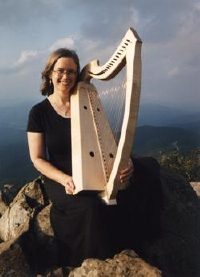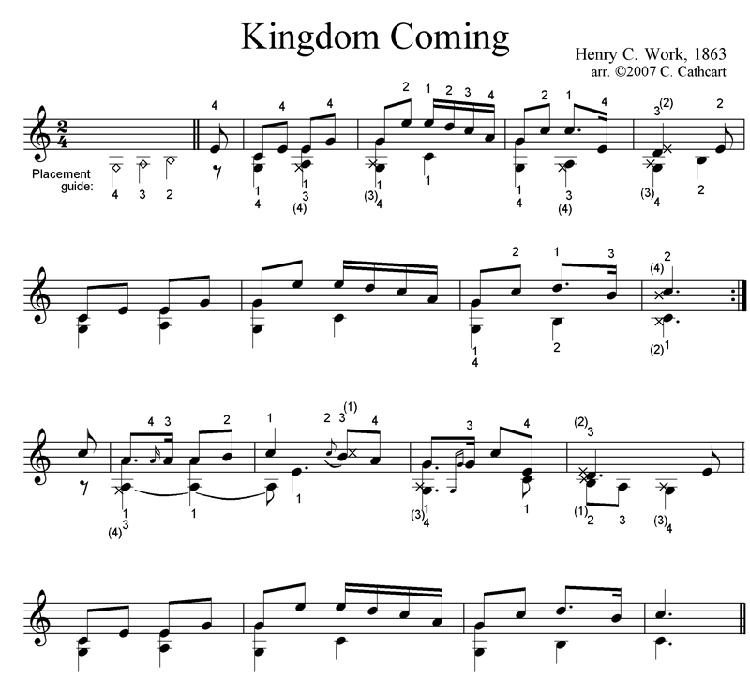Ringing Strings –
Kingdom Coming
Originally published in the Folk Harp Journal Summer 2007
An argument can be made that the wire–strung harp never went extinct. I ponder this sometimes, and often wonder what it would be like if the clarsach had come with my ancestors when they settled in the Blue Ridge Mountains of America.
Would that music work on my wire–strung harp? I wondered. Could this be the American music I take to the Edinburgh Festival [to play in my concert there]? I wanted something other than “On Top Of Old Smoky” (my apologies to the Stephen Foster fans out there). After perusing the website for the festival, and seeing the variety of music and styles, I decided it was worth a serious look.

Cynthia with her Ardival Rose clarsach in the Blue Ridge Mountains.
And so, I took my Grandfather’s other music. Not the music of Scotland, the land of his birth, but the music that was shared on his farm when I was a little girl sitting on the porch of the big farm house in the evenings. The instruments came out after the day’s work was finished, and songs were shared. If only someone had a clarsach along with the fiddle and mandolin. What would the music have sounded like then?
For me, the best thing that came of being invited to the harp festival was being inspired to discover that the music of my American childhood fit wonderfully well on the clarsach of my Grandfather’s motherland. I share with you here one of the tunes I played in my “American Set” for my concert in Edinburgh, on a very small (19 string) harp.
The tune is by Henry C. Work. Mr Work was a songwriter in 19th century America. He was born in Connecticut in 1832, the son of an abolitionist, and the tune given here is proof that Henry shared his father’s passion. “Kingdom Coming” was possibly the most popular song in America in the middle of the 19th century. Legend has it that this song was sung by the Union soldiers as they marched victorious into Richmond, Virginia, after Robert E. Lee surrendered to Ulysses S. Grant at Appomattox Courthouse. [1]
This arrangement of “Kingdom Coming” suits a resonant, long–ringing harp. Because the strings in the bass of such a harp can ring for a very long time, it is often desirable to use plenty of damping in that range. It is also not necessary to play a lot of notes in that low range for the very same reason. Thus, clarsairs will often use the “flexible thumb” of the bass hand to aid in the production of the melody, if for no other reason than to give it an equal amount of work to do in comparison to the treble hand. This arrangement uses this technique.
The bass hand thumb is often used to play the melody notes on the strong beats, which is appropriate, given the thumb’s strength relative to the fingers. This helps keep the tune steady, freeing the treble hand to embellish with ornaments or grace notes around the melody notes the bass hand plays. This is similar to the way a male dancer will guide and support his partner as she performs the prescribed dance steps (the other melody notes) as well as twirling and spinning (the ornaments). Thus I sometimes call the technique “Dancing Hands.”
Observe how the bass hand fingers stay in a fixed position in this arrangement. The fingers numbered 2, 3, and 4 work cooperatively to perform the accompaniment, working together to strike and damp the lower strings. The flexible thumb moves around as it assists the treble hand in playing the melody. The treble hand fills in the rest of the melody notes and also decorates the melody with some extra notes...the ornamentation.
My colleague Ann Heymann touches upon the core of this technique in her book Coupled Hands for Harpers (2000, see pages 11 and 13). Where our techniques diverge is that she has developed a system in which the bass hand uses only the third finger to strike the strings, [2] and the second and fourth fingers only damp strings, thus requiring the harper to reposition the bass hand every time the bass note changes. [3] Cooperative damping is used infrequently, and is limited to just two fingers working together. [4] In contrast, the emphasis in Dancing Hands is upon equal cooperation of the three fingers in the bass hand, with the thumb primarily involved in melody production. The result is that all three fingers of the bass hand strike and damp strings, in a cooperative fashion.
The bass hand often stays fixed in the Dancing Hands technique, and it is amazing how often this placement on three strings works in arranging tunes, as is amply illustrated in the arrangement of “Kingdom Coming” presented here. One positive consequence of using this technique is the limited number of jumps the bass hand needs to make, because the fingers stay in touch with the strings. Remember, every time you remove your hand entirely from your harp strings, you risk landing in the wrong place when you return. By using the flexible thumb and allowing the bass hand fingers to equally share in striking and damping, we can play with greater confidence and direct more of our attention to the melody.
I performed this arrangement of “Kingdom Coming.” in my concert at the 2007 Edinburgh International Harp Festival, and it was very well received. My wire–strung harp class even asked about it. So one evening later that week, back in my room at the bed and breakfast, I sat down and wrote out the music for the first time so I could share it with them. I share the same tune here now with you. And that’s what the EIHF is really all about: sharing our love of harps and music with each other.
To download a pdf of this music, click here: Kingdom Coming pdf
The lyrics are below the music — Guideline to Notation

Guidelines to the Notation
Back to the musicAn x–head on a staff indicates exactly which string to damp, and the parenthetical finger number tells you which finger to damp it with.
Notes with stems only going up in this arrangement indicate a note to be played with the treble hand.
Any note with the stem going down, or both up and down, is a note to be played with the bass hand.
Kingdom Coming (or The Year of Jubilo)
Say brothers, did you see the master with a mustache on his face
Go ’long the road some time this mornin’ like he’s gonna leave this place.
He seen the smoke right up the river, where old Lincoln’s gunboats lay.
He took his hat and left ver’ sudden and I ’spect he’s run away!Refrain:
The master run? Ha ha! And the workers stay, Ho ho!
It must be now the Kingdom’s comin’ in the year of Jubilo!He’s six foot one way, two foot t’other and he weigh three hundred pounds
His coat so big he couldn’ pay th’ tailor and it don’t go halfway ’round.
He drill so much they call him Cap’n and he got so dreadful tan’
I ’spect he’ll try and foll them Yankees for to think he’s contraband!Refrain:
Us workers feel so lonesome livin’ in the cabin on the lawn,
We moved our things to master’s parlor for to keep it while he’s gone.
Thar’s wine an’ bacon in the kitchen, an’ we all had best have some.
I s’pose it will be confiscated when ol’ Lincoln’s soldiers come.Refrain:
The overseer, he make us trouble, and he drive us ’round a spell.
We lock him up in the smokehouse cellar with the key throwed in the well.
The whip is lost, the handcuff broken, but the master’ll have his pay.
He’s old enough, big enough, oughta know better than to up an’ run away.Refrain:
Endnotes:
[1] Erbson, Wayne. Backpocket Old–Time Song Book (Native Ground Music, 1981) p. 14
[2] Heymann, Ann. Coupled Hands for Harpers (Clairseach Music, 2000) p. 14
[3] Heymann, p. 16
[4] Heymann, p. 64 This technique is called “Forked Finger” by Ann Heymann, based upon her interpretation of a footnote in Edward Bunting’s The Ancient Music of Ireland (1840). Please also note that the second and fourth fingers necessarily strike (rather than only damp) for playing chords (beginning on page 100 in her book).
Some editorial changes were made to this article, mainly to suit a new layout as an internet website rather than a journal article.